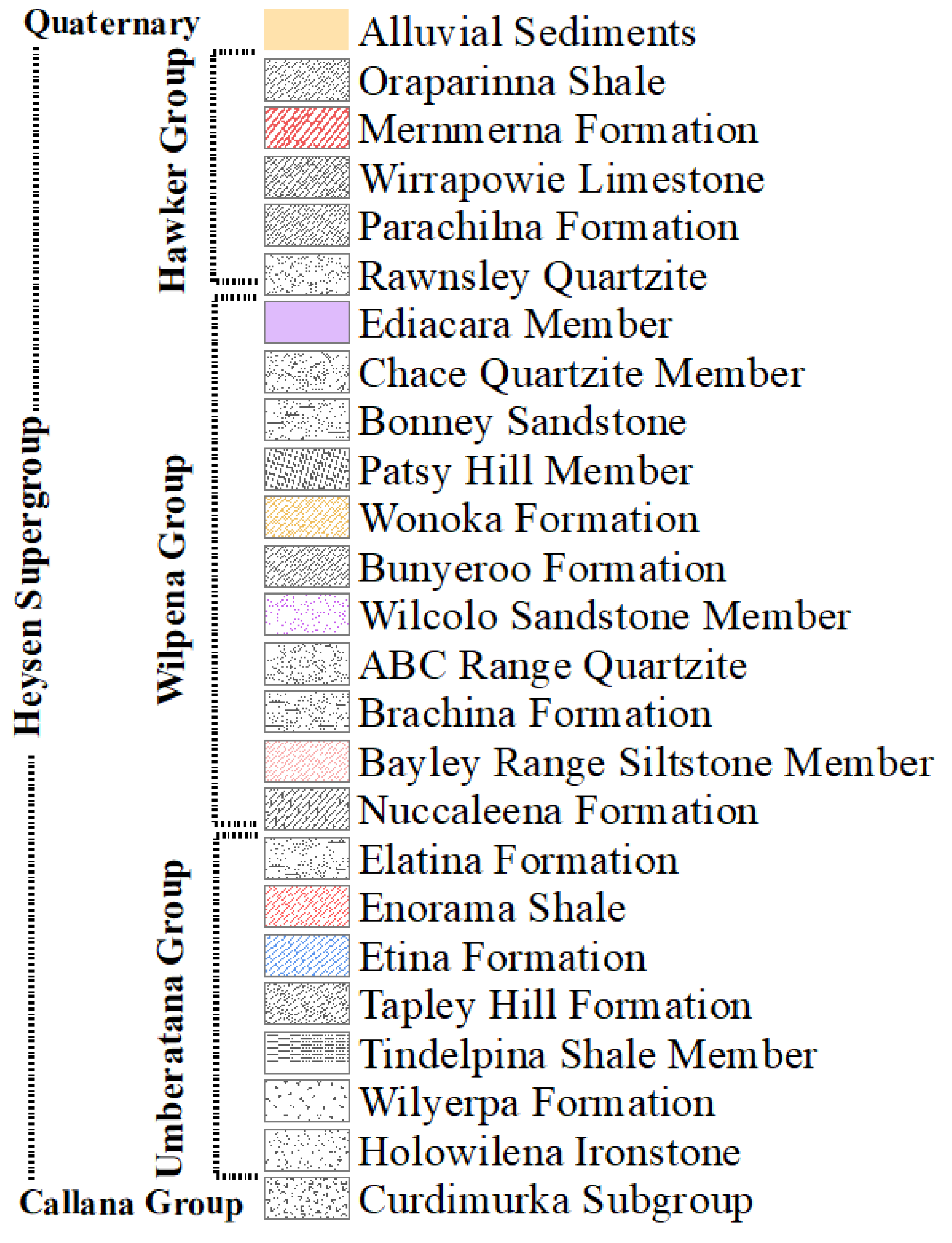Identification of Groundwater Potential Recharge Zones in Flinders Ranges, South Australia Using Remote Sensing, GIS, and MIF Techniques
Abstract
:1. Introduction
1.1. Overview of the Study Area
1.2. Geology and Hydrogeology
2. Materials and Methods
2.1. Processing and Extraction of Thematic Layers
2.2. Multi-Influencing Factors Approach (MIF)
2.3. Verification of the GWRP
3. Results
3.1. Influencing Factors
3.1.1. Drainage and Drainage Density
3.1.2. Lineament and Lineament Density
3.1.3. Topographic and Slope Features
3.1.4. Lithology and Landcover
3.1.5. Rainfall
3.2. Recharge Potential Model
3.3. Verification of the Recharge Potential Model
4. Discussions
5. Conclusions
Author Contributions
Funding
Institutional Review Board Statement
Informed Consent Statement
Data Availability Statement
Acknowledgments
Conflicts of Interest
References
- Barnett, S.; Harrington, N.; Cook, P.; Simmons, C.T. Groundwater in Australia: Occurrence and Management Issues. In Sustainable Groundwater Management; Springer: Berlin/Heidelberg, Germany, 2020; pp. 109–127. [Google Scholar]
- Pigram, J. Australia’s Water Resources: From Use to Management; CSIRO Publishing: Clayton South, Australia, 2007. [Google Scholar]
- Selvam, S.; Magesh, N.; Chidambaram, S.; Rajamanickam, M.; Sashikkumar, M. A GIS based identification of groundwater recharge potential zones using RS and IF technique: A case study in Ottapidaram taluk, Tuticorin district, Tamil Nadu. Environ. Earth Sci. 2015, 73, 3785–3799. [Google Scholar] [CrossRef]
- Souissi, D.; Msaddek, M.H.; Zouhri, L.; Chenini, I.; El May, M.; Dlala, M. Mapping groundwater recharge potential zones in arid region using GIS and Landsat approaches, southeast Tunisia. Hydrol. Sci. J. 2018, 63, 251–268. [Google Scholar] [CrossRef]
- Magesh, N.S.; Chandrasekar, N.; Soundranayagam, J.P. Delineation of groundwater potential zones in Theni district, Tamil Nadu, using remote sensing, GIS and MIF techniques. Geosci. Front. 2012, 3, 189–196. [Google Scholar] [CrossRef] [Green Version]
- Ahmed, A.A.; Shabana, A.R. Integrating of remote sensing, GIS and geophysical data for recharge potentiality evaluation in Wadi El Tarfa, eastern desert, Egypt. J. Afr. Earth Sci. 2020, 172, 103957. [Google Scholar] [CrossRef]
- Edet, A.; Teme, S.; Okereke, C.; Esu, E. Lineament analysis for groundwater exploration in Precambrian Oban massif and Obudu plateau, SE Nigeria. In Proceedings of International Journal of Rock Mechanics and Mining Sciences and Geomechanics Abstracts; Elsevier Science: Amsterdam, The Netherlands, 1996; p. 215A. [Google Scholar]
- Solomon, S.; Quiel, F. Groundwater study using remote sensing and geographic information systems (GIS) in the central highlands of Eritrea. Hydrogeol. J. 2006, 14, 1029–1041. [Google Scholar] [CrossRef] [Green Version]
- Sander, P. Lineaments in groundwater exploration: A review of applications and limitations. Hydrogeol. J. 2007, 15, 71–74. [Google Scholar] [CrossRef]
- Corgne, S.; Magagi, R.; Yergeau, M.; Sylla, D. An integrated approach to hydro-geological lineament mapping of a semi-arid region of West Africa using Radarsat-1 and GIS. Remote Sens. Environ. 2010, 114, 1863–1875. [Google Scholar] [CrossRef]
- Eilers, V.; Carter, R.C.; Rushton, K.R. A single layer soil water balance model for estimating deep drainage (potential recharge): An application to cropped land in semi-arid North-east Nigeria. Geoderma 2007, 140, 119–131. [Google Scholar] [CrossRef] [Green Version]
- Maliva, R.G.; Clayton, E.A.; Missimer, T.M. Application of advanced borehole geophysical logging to managed aquifer recharge investigations. Hydrogeol. J. 2009, 17, 1547–1556. [Google Scholar] [CrossRef]
- Daesslé, L.; Pérez-Flores, M.; Serrano-Ortiz, J.; Mendoza-Espinosa, L.; Manjarrez-Masuda, E.; Lugo-Ibarra, K.; Gómez-Treviño, E. A geochemical and 3D-geometry geophysical survey to assess artificial groundwater recharge potential in the Pacific coast of Baja California, Mexico. Environ. Earth Sci. 2014, 71, 3477–3490. [Google Scholar] [CrossRef]
- Chenini, I.; Msaddek, M.H.; Dlala, M. Hydrogeological characterization and aquifer recharge mapping for groundwater resources management using multicriteria analysis and numerical modeling: A case study from Tunisia. J. Afr. Earth Sci. 2019, 154, 59–69. [Google Scholar] [CrossRef]
- Singh, S.K.; Zeddies, M.; Shankar, U.; Griffiths, G.A. Potential groundwater recharge zones within New Zealand. Geosci. Front. 2019, 10, 1065–1072. [Google Scholar] [CrossRef]
- Fagbohun, B.J. Integrating GIS and multi-influencing factor technique for delineation of potential groundwater recharge zones in parts of Ilesha schist belt, southwestern Nigeria. Environ. Earth Sci. 2018, 77, 1–18. [Google Scholar] [CrossRef]
- Lentswe, G.B.; Molwalefhe, L. Delineation of potential groundwater recharge zones using analytic hierarchy process-guided GIS in the semi-arid Motloutse watershed, eastern Botswana. J. Hydrol. Reg. Stud. 2020, 28, 100674. [Google Scholar] [CrossRef]
- Vishwakarma, A.; Goswami, A.; Pradhan, B. Prioritization of sites for Managed Aquifer Recharge in a semi-arid environment in western India using GIS-Based multicriteria evaluation strategy. Groundw. Sustain. Dev. 2021, 12, 100501. [Google Scholar] [CrossRef]
- Senanayake, I.; Dissanayake, D.; Mayadunna, B.; Weerasekera, W. An approach to delineate groundwater recharge potential sites in Ambalantota, Sri Lanka using GIS techniques. Geosci. Front. 2016, 7, 115–124. [Google Scholar] [CrossRef] [Green Version]
- Yeh, H.-F.; Cheng, Y.-S.; Lin, H.-I.; Lee, C.-H. Mapping groundwater recharge potential zone using a GIS approach in Hualian River, Taiwan. Sustain. Environ. Res. 2016, 26, 33–43. [Google Scholar] [CrossRef] [Green Version]
- Arabameri, A.; Rezaei, K.; Cerda, A.; Lombardo, L.; Rodrigo-Comino, J. GIS-based groundwater potential mapping in Shahroud plain, Iran. A comparison among statistical (bivariate and multivariate), data mining and MCDM approaches. Sci. Total Environ. 2019, 658, 160–177. [Google Scholar] [CrossRef] [PubMed]
- Arshad, A.; Zhang, Z.; Zhang, W.; Dilawar, A. Mapping favorable groundwater potential recharge zones using a GIS-based analytical hierarchical process and probability frequency ratio model: A case study from an agro-urban region of Pakistan. Geosci. Front. 2020, 11, 1805–1819. [Google Scholar] [CrossRef]
- Mukherjee, I.; Singh, U.K. Delineation of groundwater potential zones in a drought-prone semi-arid region of east India using GIS and analytical hierarchical process techniques. Catena 2020, 194, 104681. [Google Scholar] [CrossRef]
- Shaban, A.; Khawlie, M.; Abdallah, C. Use of remote sensing and GIS to determine recharge potential zones: The case of Occidental Lebanon. Hydrogeol. J. 2006, 14, 433–443. [Google Scholar] [CrossRef]
- Yeh, H.-F.; Lee, C.-H.; Hsu, K.-C.; Chang, P.-H. GIS for the assessment of the groundwater recharge potential zone. Environ. Geol. 2009, 58, 185–195. [Google Scholar] [CrossRef]
- Das, S.; Pardeshi, S.D. Integration of different influencing factors in GIS to delineate groundwater potential areas using IF and FR techniques: A study of Pravara basin, Maharashtra, India. Appl. Water Sci. 2018, 8, 1–16. [Google Scholar] [CrossRef] [Green Version]
- Ahmed, A.; Ranasinghe-Arachchilage, C.; Alrajhi, A.; Hewa, G. Comparison of Multicriteria Decision-Making Techniques for Groundwater Recharge Potential Zonation: Case Study of the Willochra Basin, South Australia. Water 2021, 13, 525. [Google Scholar] [CrossRef]
- Watt, E.; Berens, V. Non-Prescribed Groundwater Resources Assessment—Alinytjara Wilurara Natural Resources Management Region; Phase 1; South Australia Government Printer: Adelaide, Australia, 2011. [Google Scholar]
- Preiss, W.V. The Adelaide Geosyncline: Late Proterozoic Stratigraphy, Sedimentation, Palaeontology and Tectonics. In Geological Survey of South Australia Bulletin; South Australia Government Printer: Adelaide, Australia, 1987. [Google Scholar]
- Paul, E.; Flöttmann, T.; Sandiford, M. Structural geometry and controls on basement-involved deformation in the northern Flinders Ranges, Adelaide Fold Belt, South Australia. Aust. J. Earth Sci. 1999, 46, 343–354. [Google Scholar] [CrossRef]
- Preiss, W. The Adelaide Geosyncline of South Australia and its significance in Neoproterozoic continental reconstruction. Precambrian Res. 2000, 100, 21–63. [Google Scholar] [CrossRef]
- Backé, G.; Baines, G.; Giles, D.; Preiss, W.; Alesci, A. Basin geometry and salt diapirs in the Flinders Ranges, South Australia: Insights gained from geologically-constrained modelling of potential field data. Mar. Pet. Geol. 2010, 27, 650–665. [Google Scholar] [CrossRef]
- Hearon IV, T.E.; Rowan, M.G.; Lawton, T.F.; Hannah, P.T.; Giles, K.A. Geology and tectonics of Neoproterozoic salt diapirs and salt sheets in the eastern Willouran Ranges, South Australia. Basin Res. 2015, 27, 183–207. [Google Scholar] [CrossRef]
- Osei-Bonsu, K.; Dennis, K.J. Robe Township Water Supply Wellfield Evaluation; Department of Water, Land and Biodiversity Conservation, South Australia Government Printer: Adelaide, Australia, 2004. [Google Scholar]
- Agarwal, R.; Garg, P. Remote sensing and GIS based groundwater potential & recharge zones mapping using multi-criteria decision making technique. Water Resour. Manag. 2016, 30, 243–260. [Google Scholar]
- Sreedevi, P.; Sreekanth, P.; Khan, H.; Ahmed, S. Drainage morphometry and its influence on hydrology in an semi arid region: Using SRTM data and GIS. Environ. Earth Sci. 2013, 70, 839–848. [Google Scholar] [CrossRef]
- Jasmin, I.; Mallikarjuna, P. Satellite-based remote sensing and geographic information systems and their application in the assessment of groundwater potential, with particular reference to India. Hydrogeol. J. 2011, 19, 729–740. [Google Scholar] [CrossRef]
- Deepika, B.; Avinash, K.; Jayappa, K. Integration of hydrological factors and demarcation of groundwater prospect zones: Insights from remote sensing and GIS techniques. Environ. Earth Sci. 2013, 70, 1319–1338. [Google Scholar] [CrossRef]
- Arya, S.; Subramani, T.; Karunanidhi, D. Delineation of groundwater potential zones and recommendation of artificial recharge structures for augmentation of groundwater resources in Vattamalaikarai Basin, South India. Environ. Earth Sci. 2020, 79, 1–13. [Google Scholar] [CrossRef]
- Nag, S.; Ghosh, P. Delineation of groundwater potential zone in Chhatna Block, Bankura District, West Bengal, India using remote sensing and GIS techniques. Environ. Earth Sci. 2013, 70, 2115–2127. [Google Scholar] [CrossRef]
- Bagyaraj, M.; Ramkumar, T.; Venkatramanan, S.; Gurugnanam, B. Application of remote sensing and GIS analysis for identifying groundwater potential zone in parts of Kodaikanal Taluk, South India. Front. Earth Sci. 2013, 7, 65–75. [Google Scholar] [CrossRef]
- Tam, V.; De Smedt, F.; Batelaan, O.; Dassargues, A. Study on the relationship between lineaments and borehole specific capacity in a fractured and karstified limestone area in Vietnam. Hydrogeol. J. 2004, 12, 662–673. [Google Scholar] [CrossRef] [Green Version]
- Şener, B.; Süzen, M.L.; Doyuran, V. Landfill site selection by using geographic information systems. Environ. Geol. 2006, 49, 376–388. [Google Scholar] [CrossRef]
- Shankar, M.R.; Mohan, G. Assessment of the groundwater potential and quality in Bhatsa and Kalu river basins of Thane district, western Deccan Volcanic Province of India. Environ. Geol. 2006, 49, 990–998. [Google Scholar] [CrossRef]
- Schumm, S.A. Evolution of drainage systems and slopes in badlands at Perth Amboy, New Jersey. Geol. Soc. Am. Bull. 1956, 67, 597–646. [Google Scholar] [CrossRef]
- Sharma, K.; Singh, H.; Pareek, O. Rainwater infiltration into a bare loamy sand. Hydrol. Sci. J. 1983, 28, 417–424. [Google Scholar] [CrossRef] [Green Version]
- Fox, D.; Bryan, R.; Price, A. The influence of slope angle on final infiltration rate for interrill conditions. Geoderma 1997, 80, 181–194. [Google Scholar] [CrossRef]
- Bronstert, A.; Niehoff, D.; Bürger, G. Effects of climate and land-use change on storm runoff generation: Present knowledge and modelling capabilities. Hydrol. Process. 2002, 16, 509–529. [Google Scholar] [CrossRef]
- Ahmed, A.; El Ammawy, M.; Hewaidy, A.G.; Moussa, B.; Hafz, N.A. Mapping of lineaments for groundwater assessment in the Desert Fringes East El-Minia, Eastern Desert, Egypt. Environ. Monit. Assess. 2019, 191, 1–22. [Google Scholar] [CrossRef] [PubMed]
- Subyani, A.M. Geostatistical study of annual and seasonal mean rainfall patterns in southwest Saudi Arabia/Distribution géostatistique de la pluie moyenne annuelle et saisonnière dans le Sud-Ouest de l’Arabie Saoudite. Hydrol. Sci. J. 2004, 49. [Google Scholar] [CrossRef] [Green Version]
- Babiker, M.; Gudmundsson, A. The effects of dykes and faults on groundwater flow in an arid land: The Red Sea Hills, Sudan. J. Hydrol. 2004, 297, 256–273. [Google Scholar] [CrossRef]
- Benjmel, K.; Amraoui, F.; Boutaleb, S.; Ouchchen, M.; Tahiri, A.; Touab, A. Mapping of groundwater potential zones in crystalline terrain using remote sensing, GIS techniques, and multicriteria data analysis (Case of the Ighrem Region, Western Anti-Atlas, Morocco). Water 2020, 12, 471. [Google Scholar] [CrossRef] [Green Version]
- Zhu, Q.; Abdelkareem, M. Mapping groundwater potential zones using a knowledge-driven approach and GIS analysis. Water 2021, 13, 579. [Google Scholar] [CrossRef]
- Krishnamurthy, J.; Venkatesa Kumar, N.; Jayaraman, V.; Manivel, M. An approach to demarcate ground water potential zones through remote sensing and a geographical information system. Int. J. Remote Sens. 1996, 17, 1867–1884. [Google Scholar] [CrossRef]
- Chang, K.-T.; Weng, C.-I. An investigation into the structure of aqueous NaCl electrolyte solutions under magnetic fields. Comput. Mater. Sci. 2008, 43, 1048–1055. [Google Scholar] [CrossRef]
- Abdelaziz, R.; Merkel, B.J. Sensitivity analysis of transport modeling in a fractured gneiss aquifer. J. Afr. Earth Sci. 2015, 103, 121–127. [Google Scholar] [CrossRef]
- Dar, T.; Rai, N.; Bhat, A. Delineation of potential groundwater recharge zones using analytical hierarchy process (AHP). Geol. Ecol. Landsc. 2020, 1–16. [Google Scholar] [CrossRef] [Green Version]
- Abd Manap, M.; Nampak, H.; Pradhan, B.; Lee, S.; Sulaiman, W.N.A.; Ramli, M.F. Application of probabilistic-based frequency ratio model in groundwater potential mapping using remote sensing data and GIS. Arab. J. Geosci. 2014, 7, 711–724. [Google Scholar] [CrossRef]
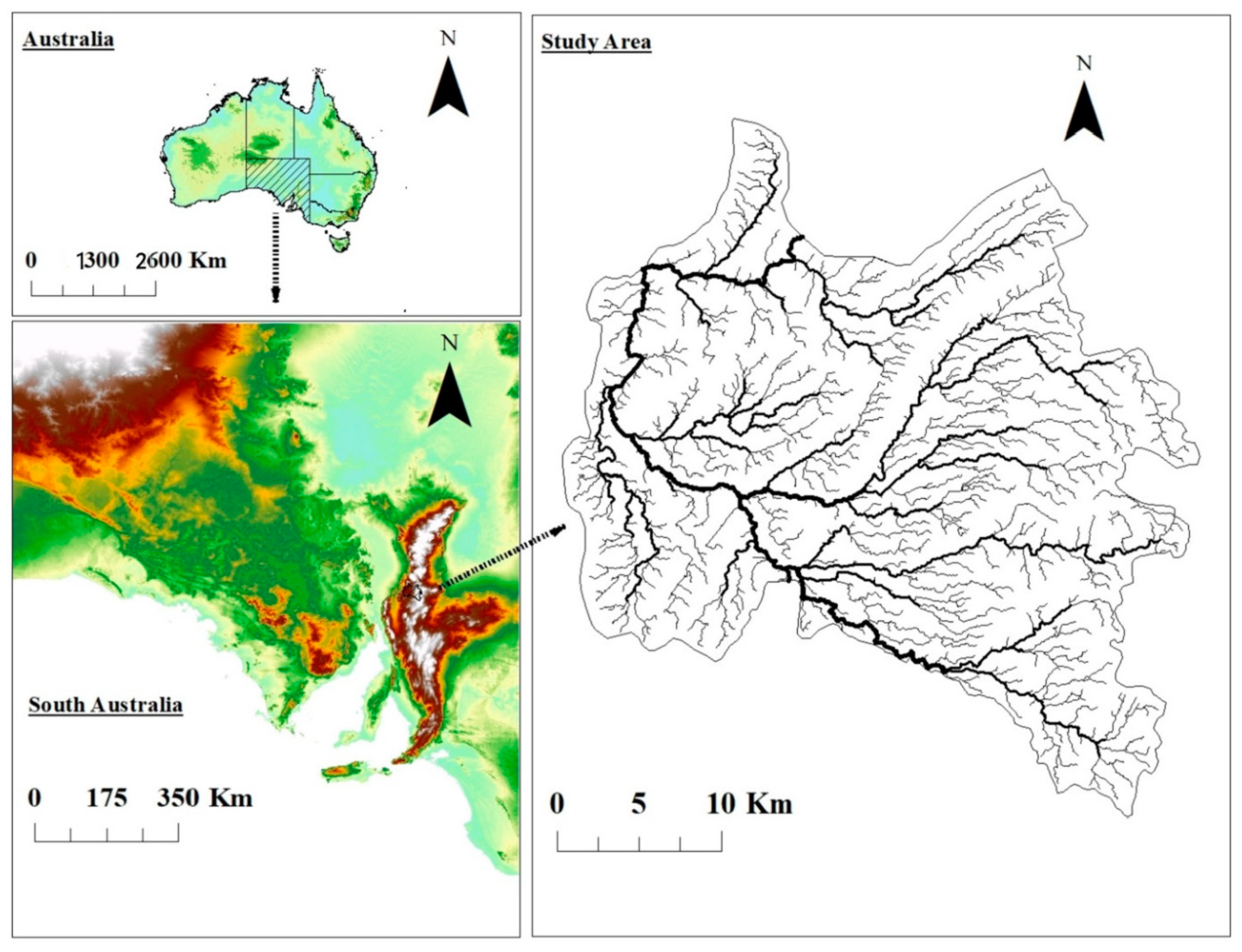

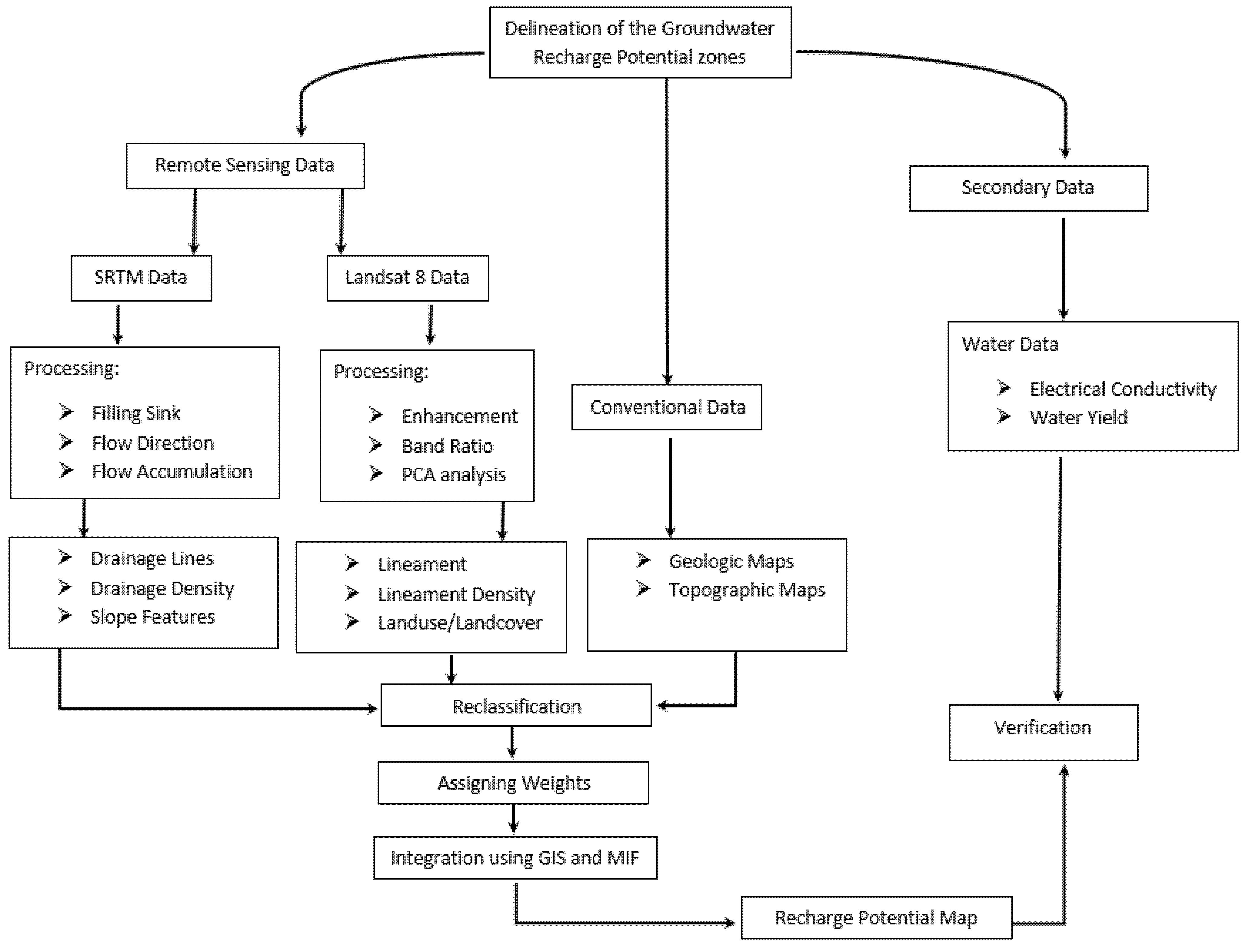
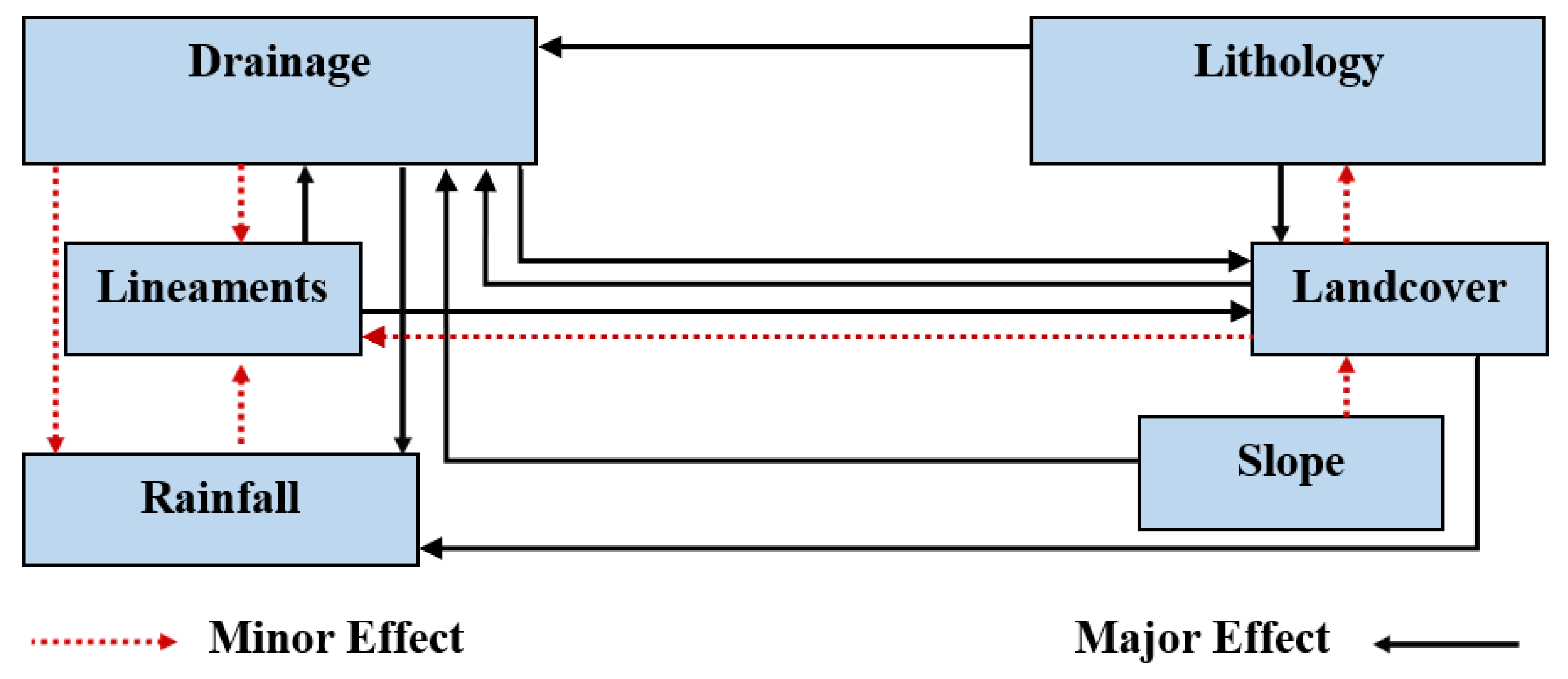
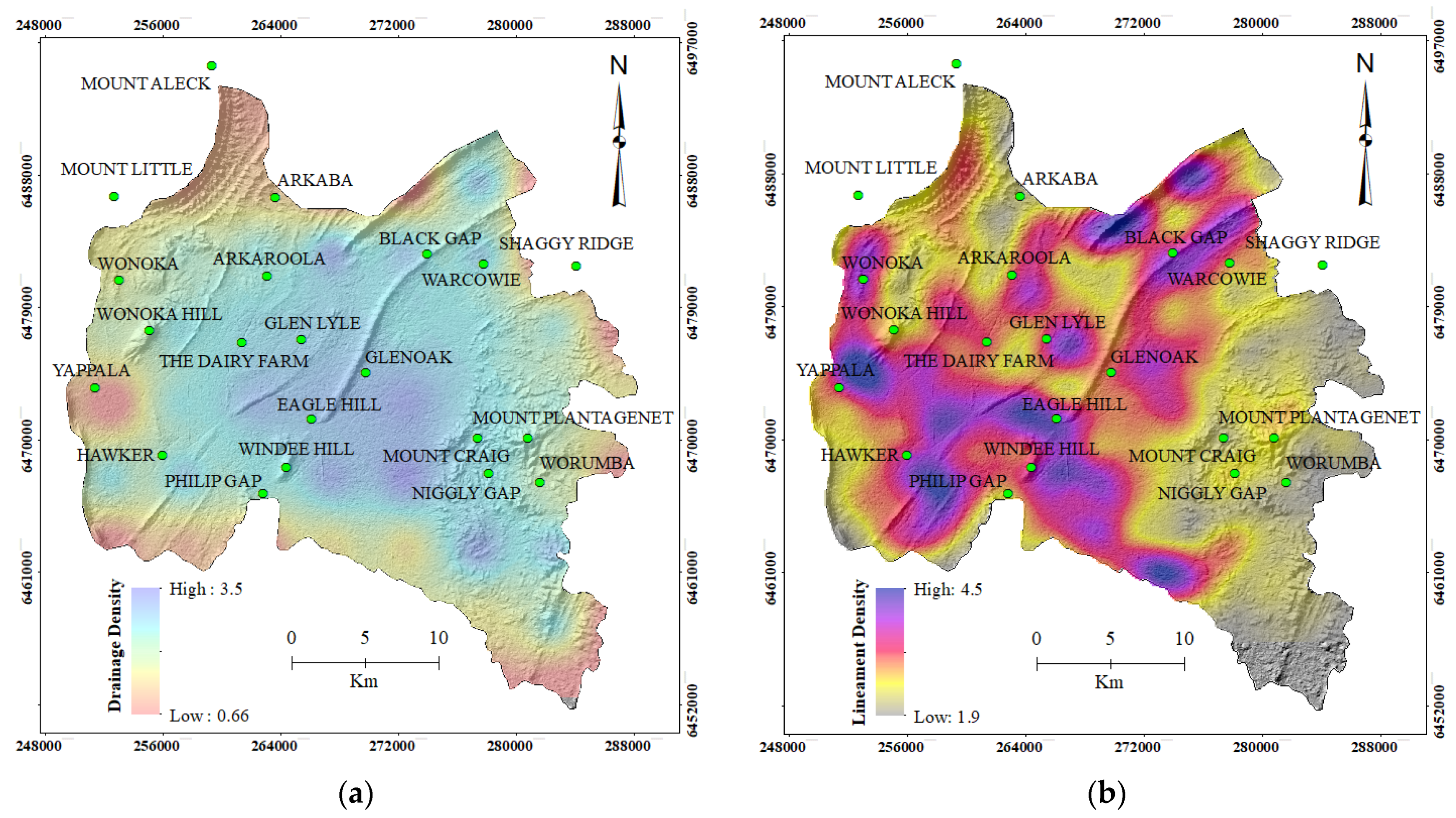
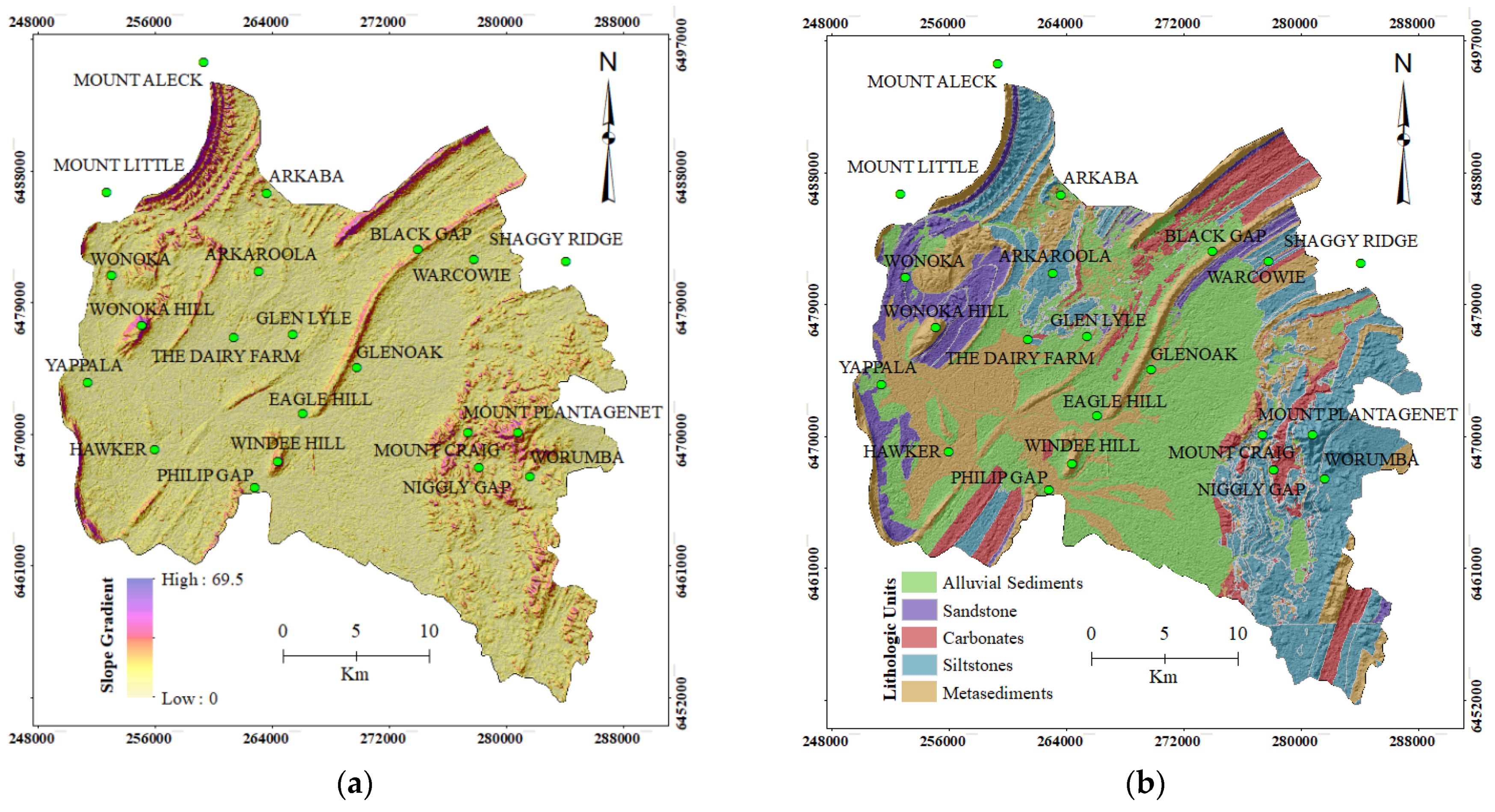
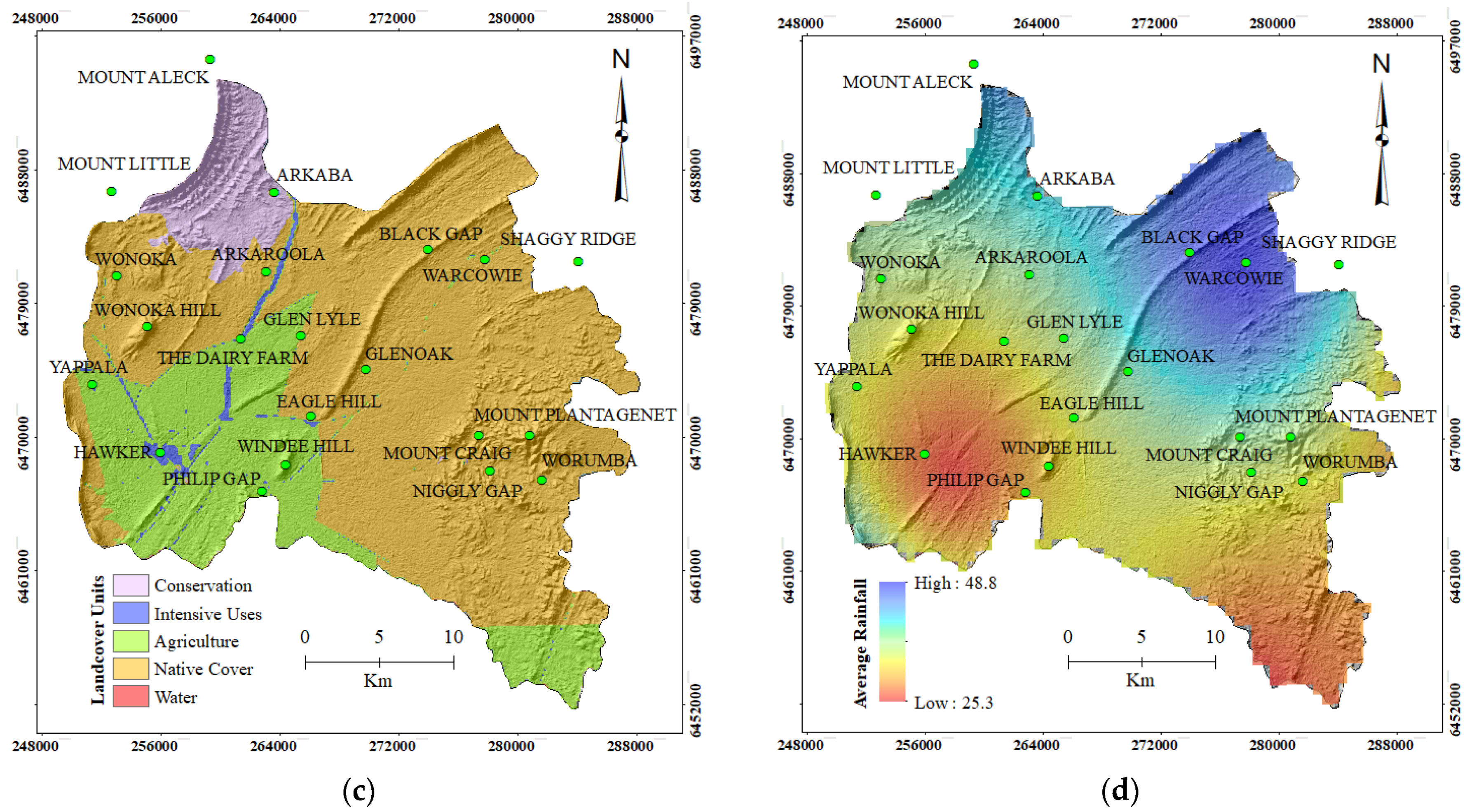
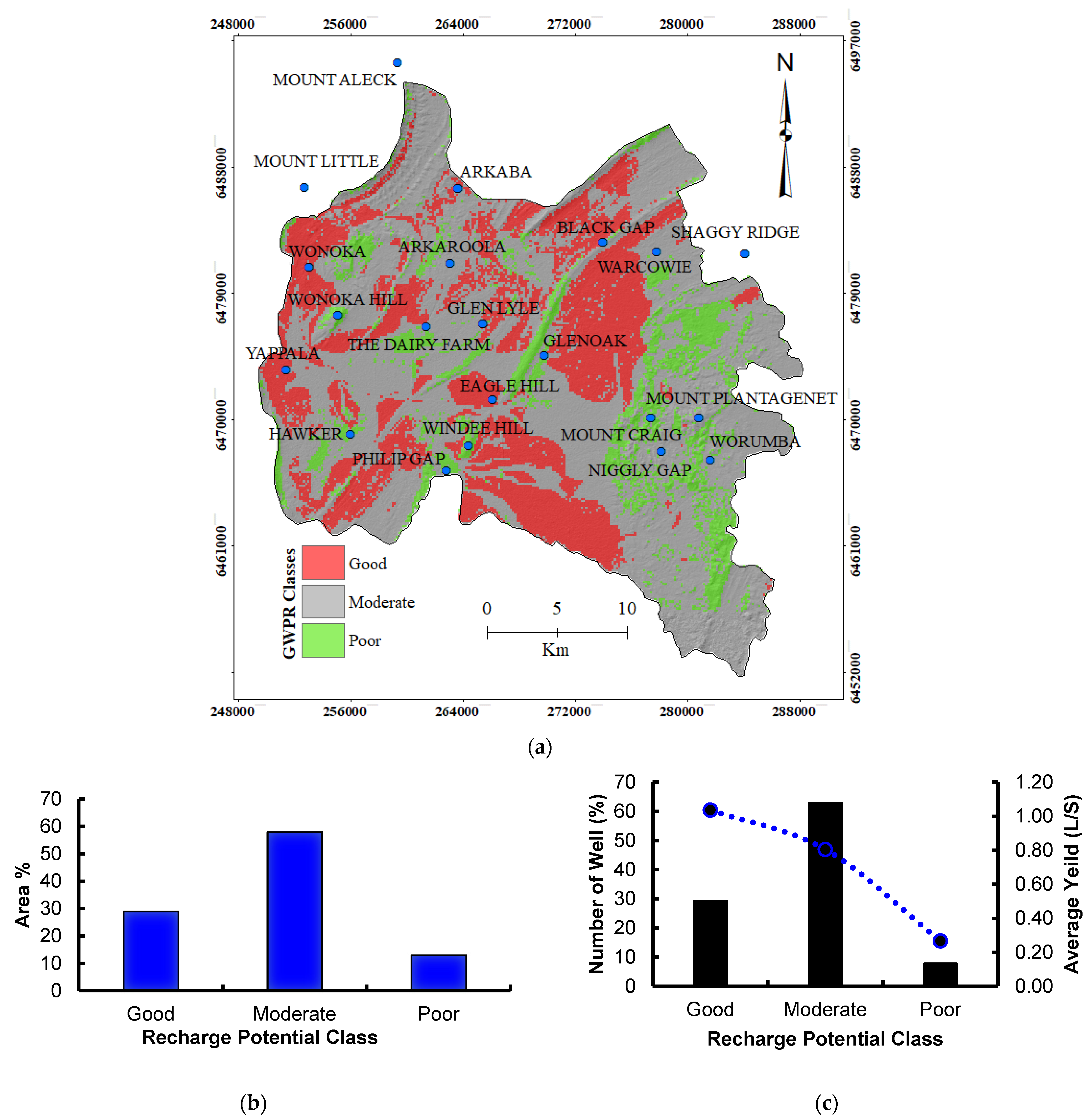
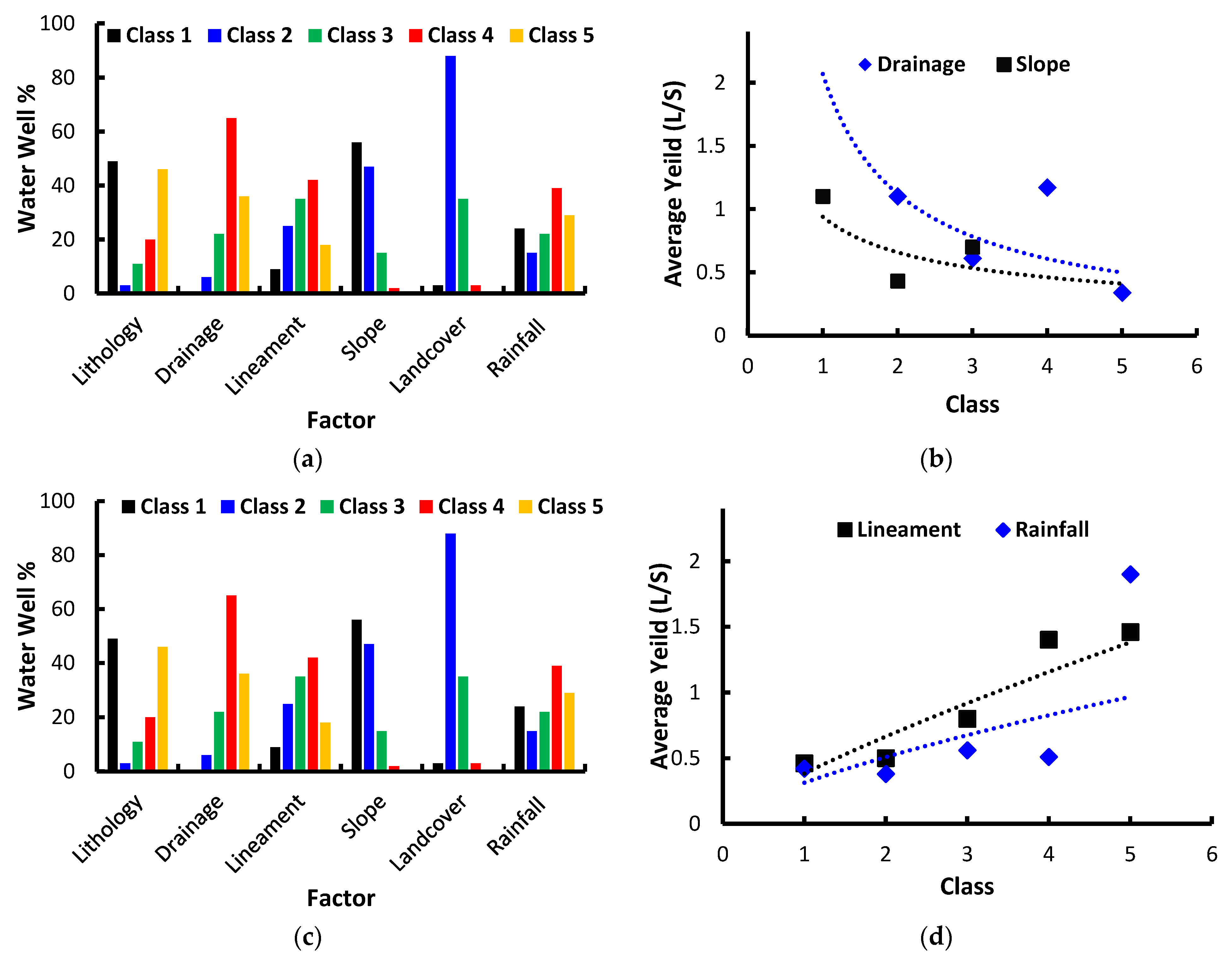
| Data/Software | Description | Source | Thematic Layer |
|---|---|---|---|
| Aster GDEM | 14 spectral bands with a spatial resolution of 90 m in the thermal infrared (TIR), 30 m in the short-wave infrared (SWIR), and 15 m in the visible and near-infrared (VNIR). | https://earthdata.nasa.gov/ (accessed on 12 July 2021) | Drainage |
| Landsat Images | 9 spectral bands with a spatial resolution of 30 m for bands 1 to 7 and 9 and 15 m for band 8 (panchromatic). | https://earthexplorer.usgs.gov/ (accessed on 12 July 2021) | Lineaments landuse |
| Topographic Map | 1:50,000 | https://map.sarig.sa.gov.au/ (accessed on 12 July 2021) | Topography |
| Geologic Map | 1:250,000 | Geology | |
| Borehole data | https://map.sarig.sa.gov.au/ (accessed on 12 July 2021) | Water layers |
| Influencing Factor | Major Effect (A) | Minor Effect (B) | Sum (A + B) | Proposed Score of Each Factor |
|---|---|---|---|---|
| Lineament | 1 + 1 | 0 | 2 | 19 |
| Lithology | 1 + 1 | 0 | 2 | 19 |
| Drainage | 1 | 0.5 | 1.5 | 14 |
| Landcover | 1 + 1 | 0.5 | 2.5 | 24 |
| Slope | 1 | 0.5 | 1.5 | 14 |
| Rainfall | 0 | 0.5 + 0.5 | 1 | 10 |
| ∑10.5 | ∑100 |
| Parameter | Zone | Total Score | Individual Score |
|---|---|---|---|
| Lithology | Alluvial sediments | 19 | 19 |
| Sandstones | 15 | ||
| Carbonates | 11 | ||
| Shale and siltstone | 7 | ||
| Metasediments | 3 | ||
| Lineament density (Km/Km) | <0.05–0.25 | 19 | 19 |
| 0.26–0.36 | 15 | ||
| 0.37–0.46 | 11 | ||
| 0.47–0.57 | 7 | ||
| >0.58–0.79 | 3 | ||
| Average slope (°) | <2 | 14 | 14 |
| 2.01–4.00 | 11 | ||
| 4.01–11 | 8 | ||
| 11.01–20.00 | 5 | ||
| >30.00 | 2 | ||
| Landuse and landcover | Water bodies | 24 | 24 |
| Grazing | 19 | ||
| Agriculture | 14 | ||
| Conservation | 9 | ||
| Industrial | 4 | ||
| Drainage density (Km./Km.) | Less than 0.25 | 14 | 14 |
| 0.26–0.33 | 11 | ||
| 0.34–0.39 | 8 | ||
| 0.4–0.46 | 5 | ||
| More than 0.46 | 2 | ||
| Rainfall (mm) | 25–30 | 10 | 10 |
| 30–35 | 8 | ||
| 35–40 | 6 | ||
| 40–45 | 4 | ||
| 45–50 | 2 |
| Parameter | Formula | 1st | 2nd | 3rd | 4th | 5th | 6th | Total |
|---|---|---|---|---|---|---|---|---|
| Number of streams | Nu | 2956 | 1359 | 746 | 424 | 213 | 172 | 5870 |
| Number% | 50.36 | 23.15 | 12.71 | 7.22 | 3.63 | 0.03 | ||
| Stream length | Lu | 1280 | 646 | 317 | 195 | 81 | 71 | 2589 |
| Mean length | Lsm = Lu/Nu | 0.43 | 0.48 | 0.42 | 0.46 | 0.38 | 0.41 |
Publisher’s Note: MDPI stays neutral with regard to jurisdictional claims in published maps and institutional affiliations. |
© 2021 by the authors. Licensee MDPI, Basel, Switzerland. This article is an open access article distributed under the terms and conditions of the Creative Commons Attribution (CC BY) license (https://creativecommons.org/licenses/by/4.0/).
Share and Cite
Ahmed, A.; Alrajhi, A.; Alquwaizany, A.S. Identification of Groundwater Potential Recharge Zones in Flinders Ranges, South Australia Using Remote Sensing, GIS, and MIF Techniques. Water 2021, 13, 2571. https://doi.org/10.3390/w13182571
Ahmed A, Alrajhi A, Alquwaizany AS. Identification of Groundwater Potential Recharge Zones in Flinders Ranges, South Australia Using Remote Sensing, GIS, and MIF Techniques. Water. 2021; 13(18):2571. https://doi.org/10.3390/w13182571
Chicago/Turabian StyleAhmed, Alaa, Abdullah Alrajhi, and Abdulaziz S. Alquwaizany. 2021. "Identification of Groundwater Potential Recharge Zones in Flinders Ranges, South Australia Using Remote Sensing, GIS, and MIF Techniques" Water 13, no. 18: 2571. https://doi.org/10.3390/w13182571
APA StyleAhmed, A., Alrajhi, A., & Alquwaizany, A. S. (2021). Identification of Groundwater Potential Recharge Zones in Flinders Ranges, South Australia Using Remote Sensing, GIS, and MIF Techniques. Water, 13(18), 2571. https://doi.org/10.3390/w13182571





